Topic 5: On the Wild Side
0.0(0)
0.0(0)
Card Sorting
1/134
Earn XP
Description and Tags
Study Analytics
Name | Mastery | Learn | Test | Matching | Spaced |
|---|
No study sessions yet.
135 Terms
1
New cards
What is a Habitat?
* The place where an organism lives
* Can be large or small
* Can be large or small
2
New cards
What are small habitats called?
* Microhabitats
3
New cards
Why do organisms live in certain habitats?
* Species are adpted, or ell-suited, to life in a particular habitat
4
New cards
What is a habitat specialist?
* Species that can only survive in a very specific habitat
5
New cards
Whatt is a habitat generalist?
* Can survive in a range of habitats
* More likely to invade and take over a new habitat
* More likely to invade and take over a new habitat
6
New cards
What is an ivasice specis?
* Species that invade and take over a new habitat
* Humans sometimes release new species into a habitat, accidentally or on purpose.
* They disrupt the normal speces interactions ina habitat and cause serious problems
* Humans sometimes release new species into a habitat, accidentally or on purpose.
* They disrupt the normal speces interactions ina habitat and cause serious problems
7
New cards
What is a population?
* All the individuals of one species living in a habitat
8
New cards
What is species abundance?
* The measure of the size of a population
* How many organisms of the same species
* How many organisms of the same species
9
New cards
What is species distribution?
* The exact location of a population within a habitat
10
New cards
What is a community?
* Multiple populations living and interacting in the same area
* For example, garden ponds made up of frogs, fish, newts, water lillies and all othr populations living in the pond
* For example, garden ponds made up of frogs, fish, newts, water lillies and all othr populations living in the pond
11
New cards
What is an ecosystem?
* A community and its interactions with non-living parts of its habitat
* Both biotic and abiotic components in an ecosystem
* Both biotic and abiotic components in an ecosystem
12
New cards
Size and scale of an ecosystem?
* The size and scale varies
* A small pond and the ocean are both ecosystems
* A small pond and the ocean are both ecosystems
13
New cards
Complexity of an ecosystem?
* The complexity varies
* Desert is a relatively simple ecosystem, tropical rainforest is complex
* Desert is a relatively simple ecosystem, tropical rainforest is complex
14
New cards
Energy in an ecosystem
* There is a flow of energy in an ecosystem and nutrients within it are recycled
15
New cards
Ecosystem Interactions
* Ecosystems often influence other ecosystems
* Organisms from one ecosystem move to another
* Birds migrate long distances to feed from multiple eosystems
* Organisms from one ecosystem move to another
* Birds migrate long distances to feed from multiple eosystems
16
New cards
What are species abundance and dstribution determined by?
* Combination of biotic and abiotic factors
17
New cards
What are biotic factors?
* Living factors that influence populations within their community
* Biotic factors come about as a result of the activity of other organisms
* Biotic factors come about as a result of the activity of other organisms
18
New cards
What activity of other organisms bring about biotic facotrs?
* Predation
* Food availability
* Intraspecific competition, arising when individuals of the same species compete for resources
* Interspecific competition, arising when individuals of different species compete for resources
* Cooperation between organisms
* Parasitism
* Disease
* Food availability
* Intraspecific competition, arising when individuals of the same species compete for resources
* Interspecific competition, arising when individuals of different species compete for resources
* Cooperation between organisms
* Parasitism
* Disease
19
New cards
Impacr of food availability on the community
* More food= organisms have a higher chance of surviving and reproducing.
* Populations can increase
* rainforests: large food supply→ many species
* Desert: small food supply→ few pecies
* Populations can increase
* rainforests: large food supply→ many species
* Desert: small food supply→ few pecies
20
New cards
imact of new predators on community
* In balanced ecosystems, predators catch enough prey to survive but not so many that they wipe out the prey population
* If a new predator is introduced, the ecosystem may become unbbalanced
* If a new predator is introduced, the ecosystem may become unbbalanced
21
New cards
The effect of new pathoogens on a community
* If a new pathogen enters an ecosystem, populations there will have no immunity or resistance to it and the popualtion may decline or be wiped out
22
New cards
Effect of competition on a community
* If two species comet for the same resources and one is better adapted to take advantage of these resources, then that species will outcompete the other.
* This may continue until there are to few members of the lesser adapted species to breed succesfully
* This may continue until there are to few members of the lesser adapted species to breed succesfully
23
New cards
What are abiotic factors?
* Non-living factors thatinfluence popualtions within their community
24
New cards
Examples of abiotic facotrs
* Light intensity and wavelength
* Temperature
* Turbidity, or cloudiness, of water
* Humidity
* Soil or water pH
* Soil or water salinity
* Soil composition
* Oxygen or Carbon dioxide concentration
* Temperature
* Turbidity, or cloudiness, of water
* Humidity
* Soil or water pH
* Soil or water salinity
* Soil composition
* Oxygen or Carbon dioxide concentration
25
New cards
How does light intensity influence the community?
* Light required by plants for photosynthesis
* More light leads to increase in rate of photosynthesis
* Therefore increase in plant growth rate
* More light leads to increase in rate of photosynthesis
* Therefore increase in plant growth rate
26
New cards
How does temperature influence a community?
* Affects the rate of photosynthesis in plants
27
New cards
How do moisture leves ingluence the community?
* Plants and animals require water to survive
28
New cards
How does soil PH and mineral content influence a community?
* Different plant species adapted to different PH levels and nutrient concentration levels
29
New cards
How does wind intensit and direction influence a communit?
* Wind speed affects transpiration rate in plants
* Transpiration affects the rate of photosynthesis as it ensures water and mineral ions are transported to the leaved
* Transpiration affects the rate of photosynthesis as it ensures water and mineral ions are transported to the leaved
30
New cards
How does carbon dioxide levels affect the plant community?
* CO2 required for photosynthesis in plants
* CO2 concentration affects the rate of photosynthesis
* CO2 concentration affects the rate of photosynthesis
31
New cards
How do oxygen levels affect the aquatic animal community?
* Some aquatic aniimals can only survive in water with high 02 concentrations
32
New cards
What is a niche?
* The role of a species within its habitat
* Species occupy a specific niche within its habitat
* Species occupy a specific niche within its habitat
33
New cards
What does the role a species include?
* What it eats
* Which other species depend on it for food
* What time of day a species is active
* Exactly where in a habitat a species lives
* Exactly where in a habitat a species feeds
* Which other species depend on it for food
* What time of day a species is active
* Exactly where in a habitat a species lives
* Exactly where in a habitat a species feeds
34
New cards
Competition within niches
* No two species can fill the same niche within a habitat.
* If this happens the two species will be in direct competitioin with each other for resources
* One species will out compete the other causing it to die out
* If this happens the two species will be in direct competitioin with each other for resources
* One species will out compete the other causing it to die out
35
New cards
Conditions for occupying the same niche
* There will be slight differences in their role
* Eg: they might feed at different times of the day or have different food sources
* Eg: they might feed at different times of the day or have different food sources
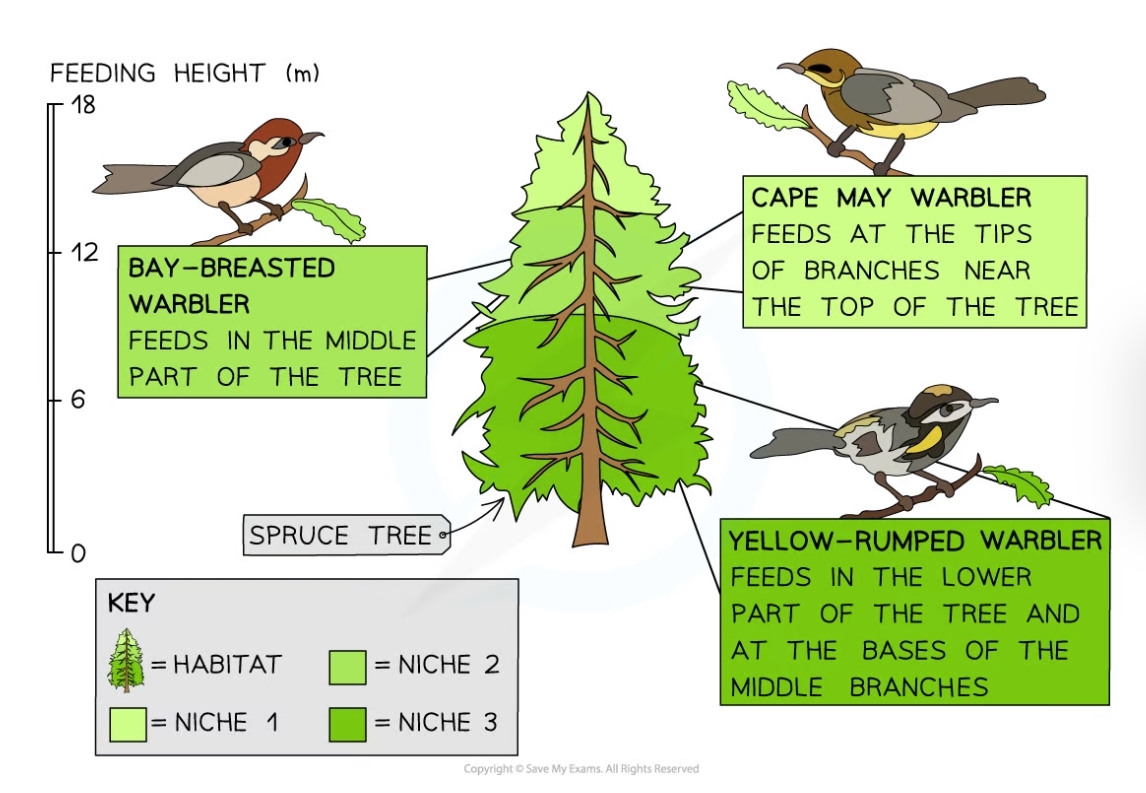
36
New cards
How does occupying the same niche affect species abundance?
* The niche filled by a pecies determines its abundance in a habitat
* If two species occupy a similar nice, they will be competing with eacother so popualtion will be smaller and therefore abundance is lower
* If two species occupy a similar nice, they will be competing with eacother so popualtion will be smaller and therefore abundance is lower
37
New cards
How does a niche filled by a species determines its distribution?
* Species can only survive in habitats where they are well adapted
* If they are not well suited to a habitat’s biotic and abiotic factors then they will move to a more suitable habitat and distribution will change
* If they are not well suited to a habitat’s biotic and abiotic factors then they will move to a more suitable habitat and distribution will change
38
New cards
Core practicl 10: Determining Distribution and abundance
* Finding out about the abundance and distribution of species can be achieved by counting all of the organisms present in a habitat
* This is possible for areas that are very small or where the species are very large
* For larger and more complex habitats it is not possible to find, identify, and count every organism that is present
* When this is the case sampling can be used to make an estimate for the total species numbers
* This is possible for areas that are very small or where the species are very large
* For larger and more complex habitats it is not possible to find, identify, and count every organism that is present
* When this is the case sampling can be used to make an estimate for the total species numbers
39
New cards
What is sampling?
* Sampling is a method of investigating the abundance and distribution of species and populations
40
New cards
What are the different types of sampling?
* Random
* Systematic
* Systematic
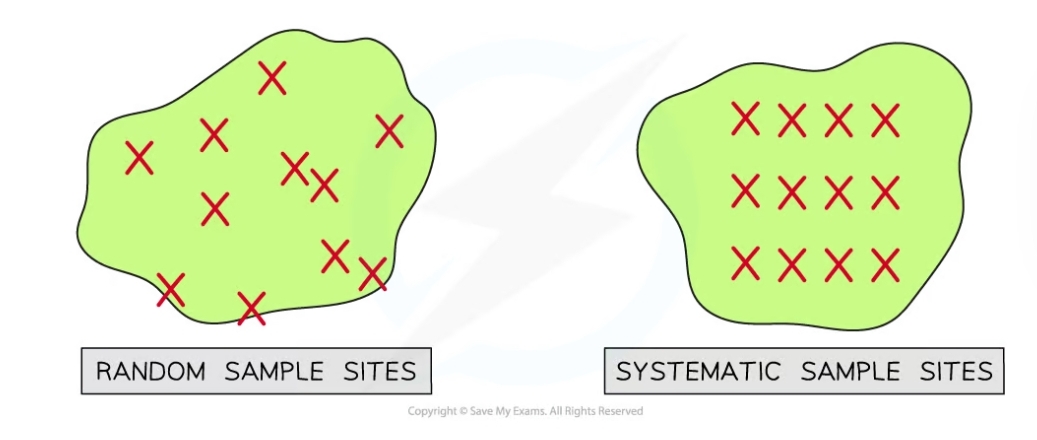
41
New cards
What is random sampling?
* The positions of the sampling points are selected at random
42
New cards
Benefits of random sampling?
* This method avoids bias by the person that is carrying out the sampling
43
New cards
How does bias effect results? (Example)
* A student might choose to carry out samples in a particular location because it looks interesting, and this might give the impression that the habitat contains more species than it really does
44
New cards
What happens in systematic sampling?
* The positions of the sampling points are located at fixed intervals throughout the sampling site
45
New cards
Benefits of systematic sampling
* This avoids accidentally missing out sections of habitat due to chance
* Systematic sampling allows researchers to investigate the effect of the presence of certain environmental features on species distribution e.g. by taking samples along a line that extends away from an environmental feature such as a river
* A line of this type is known as a transect
* Systematic sampling allows researchers to investigate the effect of the presence of certain environmental features on species distribution e.g. by taking samples along a line that extends away from an environmental feature such as a river
* A line of this type is known as a transect
46
New cards
When is random sampling best?
* When the sampling area is reasonably uniform
47
New cards
How are random sampling sites detected?
* Laying out a grid over the area to be studied
* Generating random number co-ordinates
* Placing sample sites in the grid squares that match the random number co-ordinates
* Generating random number co-ordinates
* Placing sample sites in the grid squares that match the random number co-ordinates
48
New cards
What practical methods can be used to assess species distribution and abundance?
* Frame and point quadrats
* Line and belt transects
* Line and belt transects
49
New cards
What is a frame quadrat?
* A square frame that is placed within the area to be studied to provide a sample
50
New cards
What are quadrats used for?
* Used to study the distribution of sessile organisms
51
New cards
What are sessile organisms?
* An organism that is fixed in place or immobile
52
New cards
Size of quadrats
* Can be different sizes depending on species being studied
* 1 m² quadrat can be used to study small organisms
* 400 m² quadrat can be used to study large organisms such as trees
* 1 m² quadrat can be used to study small organisms
* 400 m² quadrat can be used to study large organisms such as trees
53
New cards
In what order are quadrats placed?
* Randomly
* Systematically (along a transect)
* Systematically (along a transect)
54
New cards
What data can be recorded from a frame quadrat?
* Presence or absence of a species
* Species frequency; how many individuals are in the quadrat
* Species abundance; measured on a scale called the ACFOR
* Percentage cover; the percentage of the quadrat covered by a species
* Quadrats can be divided up into smaller squares to allow percentage cover to be assessed more easily
* Species frequency; how many individuals are in the quadrat
* Species abundance; measured on a scale called the ACFOR
* Percentage cover; the percentage of the quadrat covered by a species
* Quadrats can be divided up into smaller squares to allow percentage cover to be assessed more easily
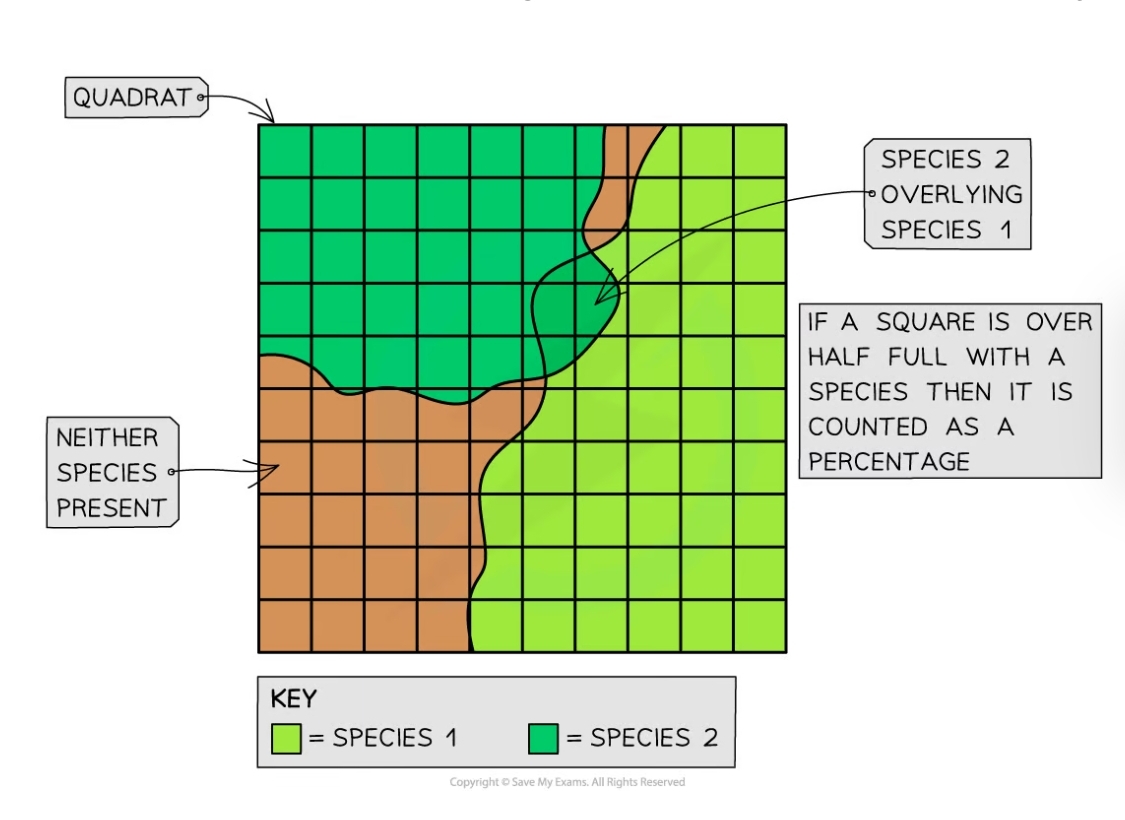
55
New cards
What is the ACFOR scale?
* Species are recorded as being abundant, common, frequent, occasional, rare, or none
56
New cards
What is a point quadrat?
* A vertical frame with holes across the top through which pins are lowered
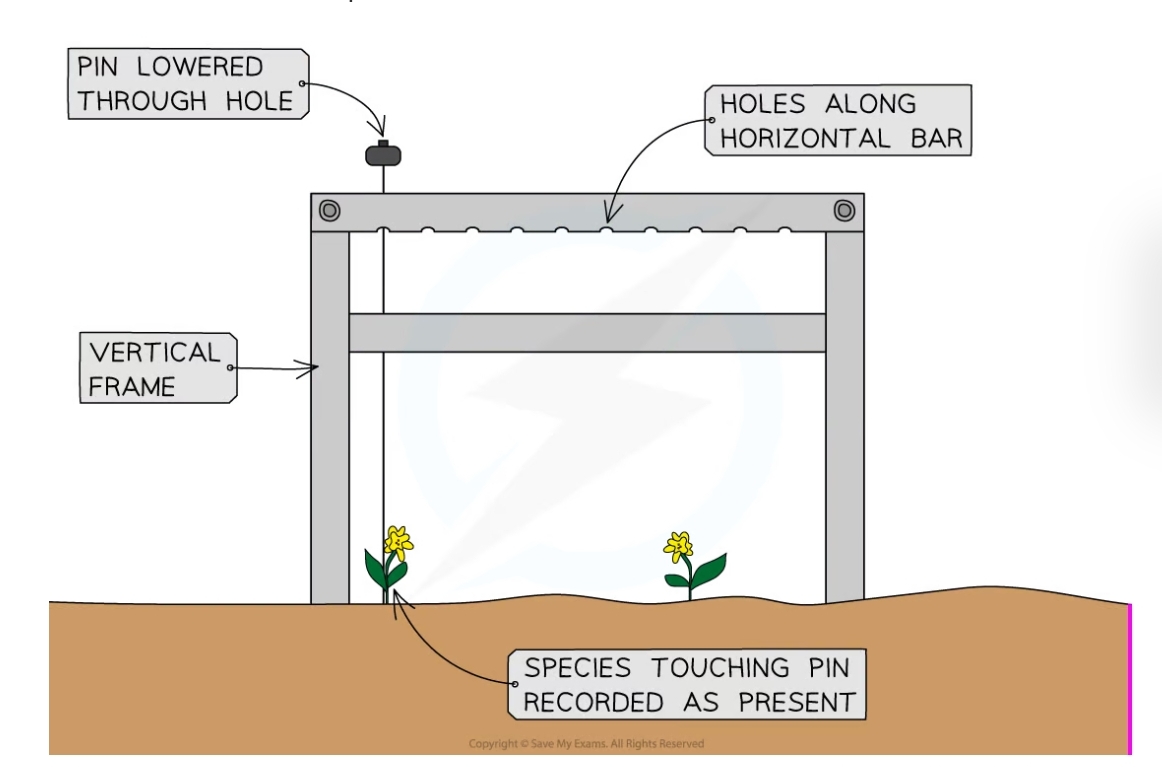
57
New cards
What areas are point quadrats useful in?
* Areas of dense plant cover as the ground may be difficult to study using a frame quadrat
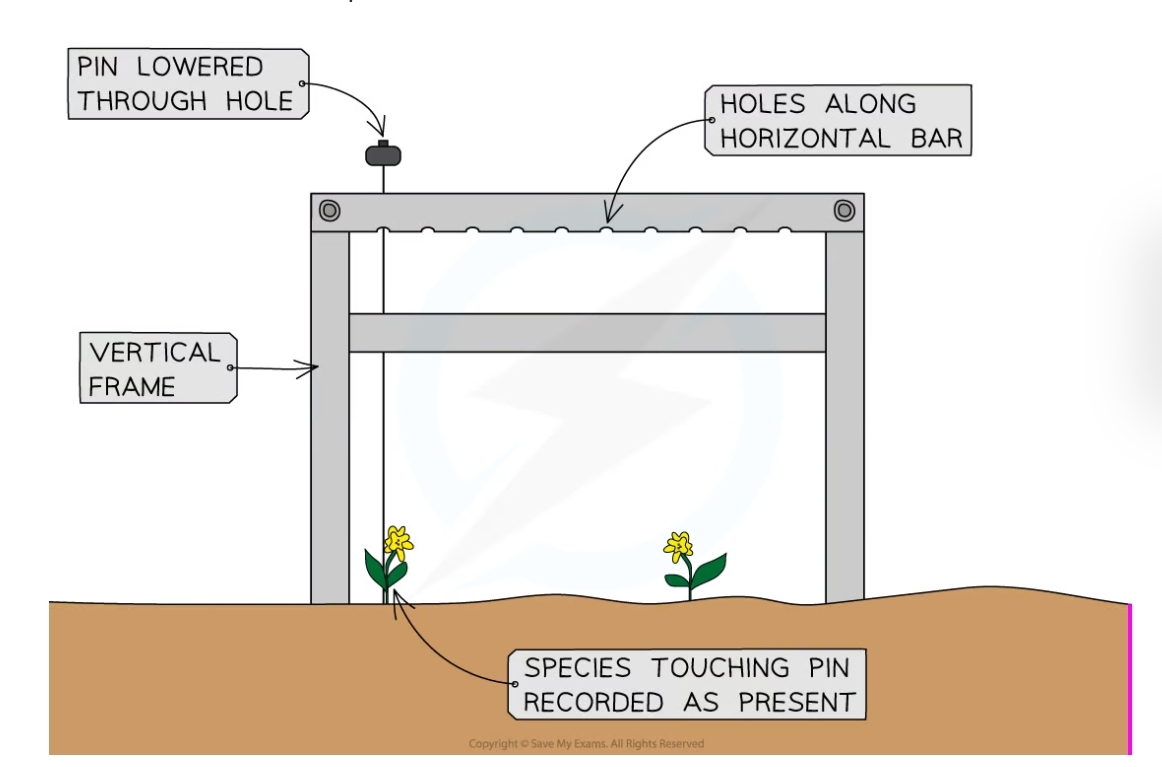
58
New cards
How can point quadrats be placed?
* Randomly
* Systematically
* Systematically
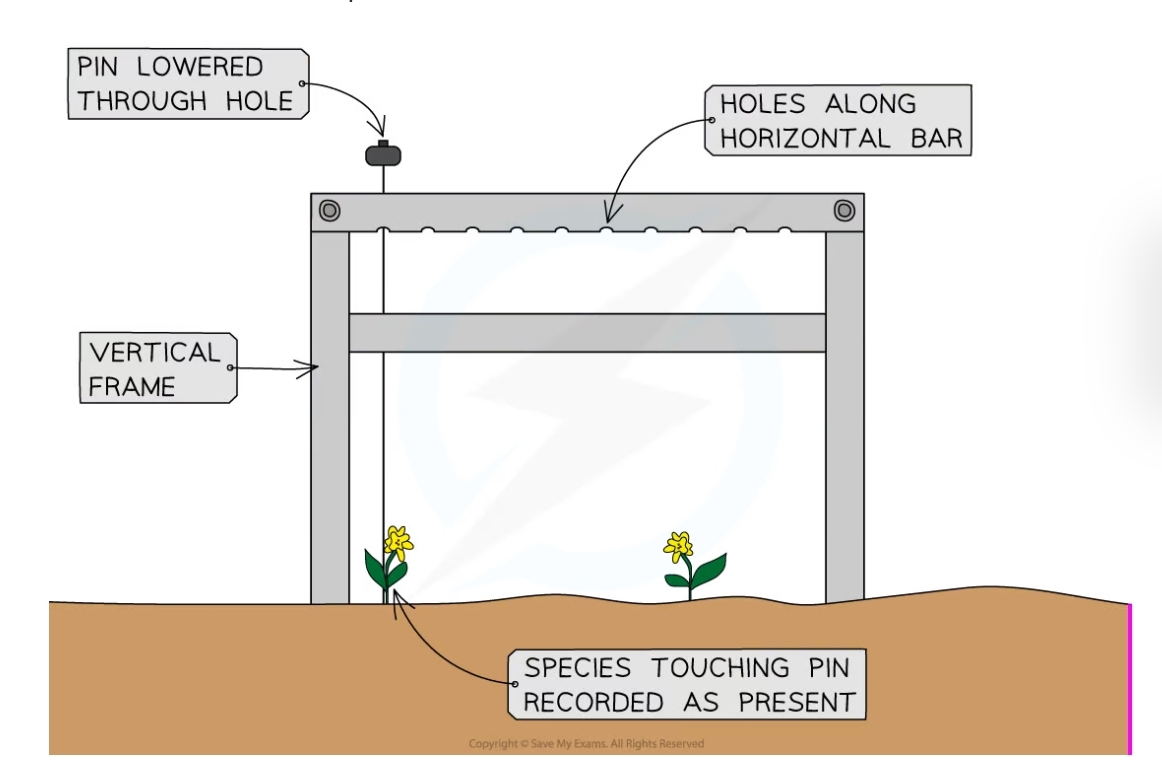
59
New cards
How does a point quadrat work?
* When a lowered pin touches a species, that species is recorded as being present
* If several species are touching the pin then all of those species are recorded
* If several species are touching the pin then all of those species are recorded

60
New cards
How can point quadrats be used to measure species abundance?
* The number of individuals of a species present
* Each individual that touches a pin is recorded
* Percentage cover of a species
* The number of pins touched by a species is divided by the total number of pins used
* Most point quadrats have ten pins, so if all the pins are used then a species touching one pin counts as 10 percent cover
* Each individual that touches a pin is recorded
* Percentage cover of a species
* The number of pins touched by a species is divided by the total number of pins used
* Most point quadrats have ten pins, so if all the pins are used then a species touching one pin counts as 10 percent cover
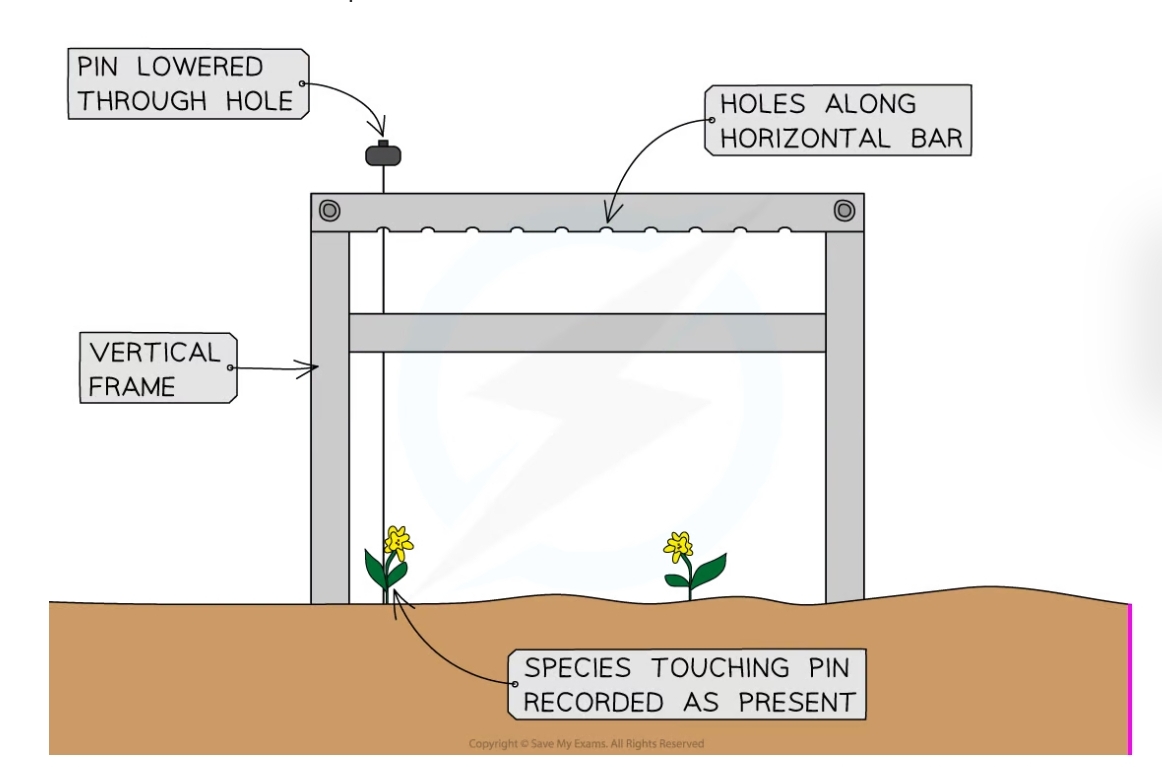
61
New cards
What is a transect?
* Lines laid out across a site that can be used to measure abundance and distribution across a habitat
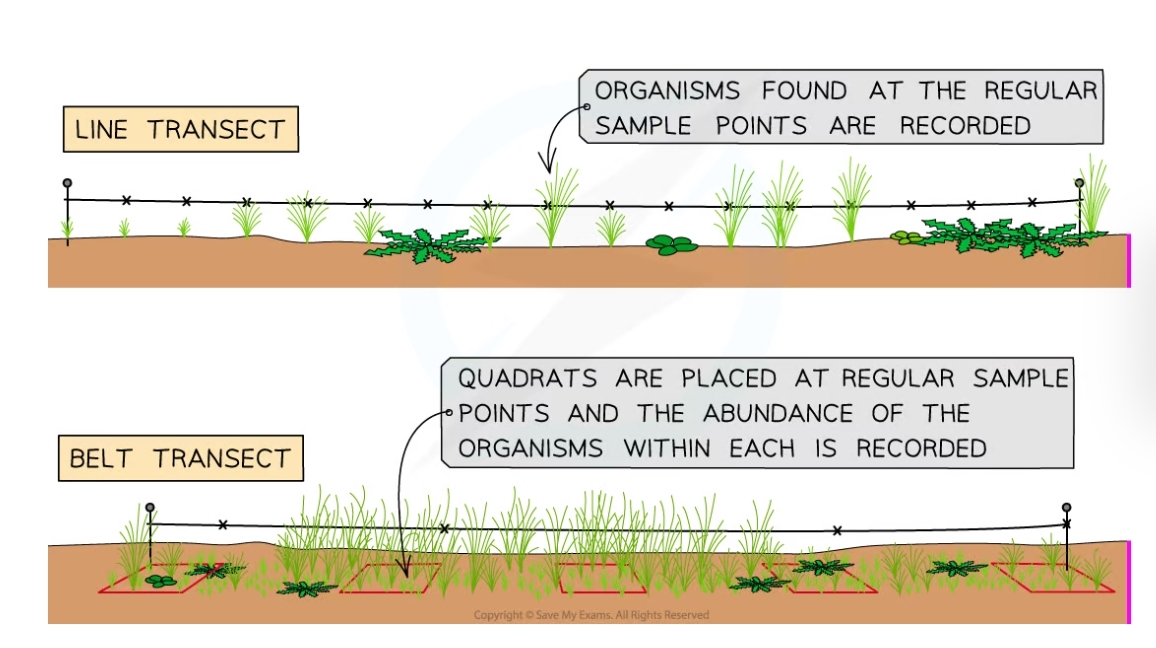
62
New cards
What are transects useful for?
* Determining how species abundance and distribution might change along a gradient
* e.g. at increasing distances from a field margin or perpendicular to the water's edge on a rocky shore
* e.g. at increasing distances from a field margin or perpendicular to the water's edge on a rocky shore
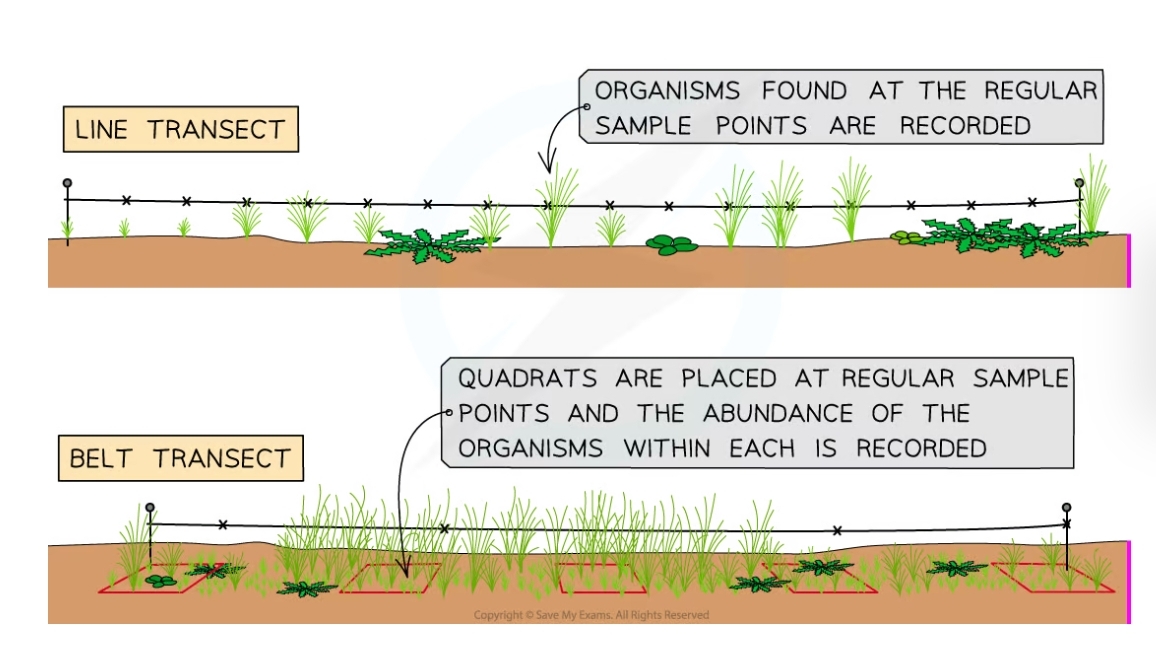
63
New cards
How is a transect carried out?
* A tape measure is laid out along the gradient of interest, and samples are taken along the line
64
New cards
What are the different ways of carrying out transect studies
* Continuous line transet
* Interrupted line transect
* Continuous belt transect
* Interrupted belt transect
* Interrupted line transect
* Continuous belt transect
* Interrupted belt transect
65
New cards
What is a continuous line transect?
* Every species touching the tape measure is recorded
66
New cards
What is an interrupted line transect?
* Species touching the line at regular intervals, e.g. every metre, are recorded
67
New cards
What is a continuous belt trnsect?
* Frame quadrats are placed end-to-end along the line
68
New cards
What is an interrupted belt transect?
* Frame or point quadrats are placed at regular intervals, e.g. every metre, along the line
69
New cards
Why is it important to measure the only the relevant abiotic factors at the sample sites?
* It is only necessary to record relevant abiotic factors
* A study may only be interested in one particular abiotic factor
* Some abiotic factors may not be relevant in certain habitats e.g. water turbidity (cloudiness) will not be relevant in a woodland habitat
* A study may only be interested in one particular abiotic factor
* Some abiotic factors may not be relevant in certain habitats e.g. water turbidity (cloudiness) will not be relevant in a woodland habitat
70
New cards
How is air temperature measured?
* Thermometer
71
New cards
How is rainfall measured?
* Rain gauge
* A funnel collects water in a measuring cylinder and the volume of water collected is recorded
* A funnel collects water in a measuring cylinder and the volume of water collected is recorded
72
New cards
How is humidity recorded?
* Hygrometer
* Electronic device that measures the water vapour content of air
* Electronic device that measures the water vapour content of air
73
New cards
How is dissolved oxygen recorded?
* Electronic oxygen sensor
74
New cards
How is water turbidity recorded?
* Turbidity meter
* Measures light scatter by particles in the water
* Or secchi disc is lowered into the water and the depth at which it is no longer visible is recorded
* Measures light scatter by particles in the water
* Or secchi disc is lowered into the water and the depth at which it is no longer visible is recorded
75
New cards
How is light intensity recorded?
* Electronic light meter
76
New cards
How is landscapre relief (changing height of land) recorded?
* Map contour lines or GPS meter
77
New cards
How is site aspect (direction that the site faces) recorded?
* Compass
78
New cards
How is slope incline measured?
* Clinometer
* The angle of a slope is measured using a specialised protractor and the incline calculated using the principles of trigonometry
* The angle of a slope is measured using a specialised protractor and the incline calculated using the principles of trigonometry
79
New cards
How is soil or water PH recorded?
* Indicator solution mixed with soil or water sample
80
New cards
How is soil water content recorded?
* Caclulating the difference in mass between a moist soil sample and the same sample after it has been dried
81
New cards
How are the results represented?
* Kite diagram
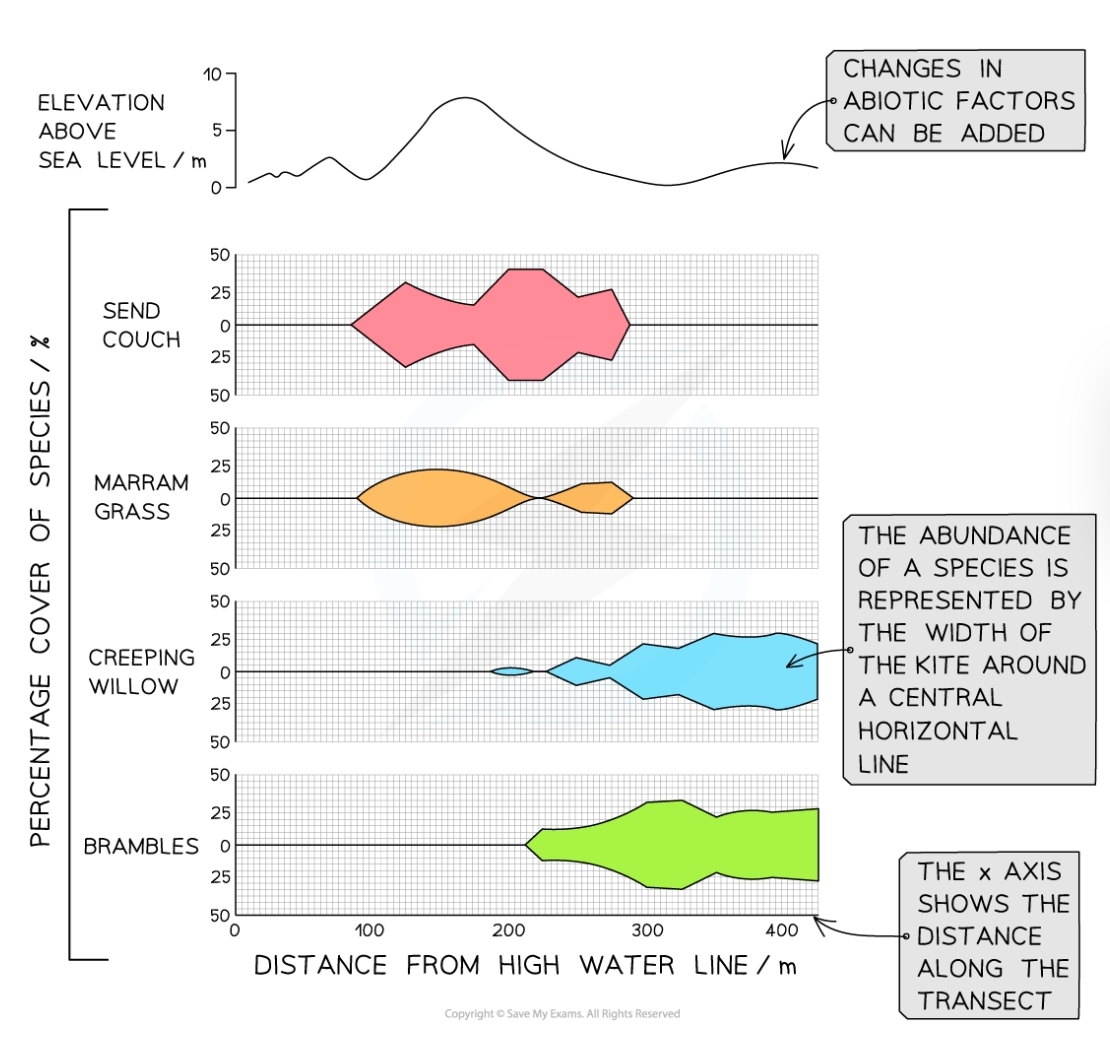
82
New cards
What do kite diagrams show?
* Distribution and abundance

83
New cards
How is distribution shown on a kite diagram?
* The distribution of a species along a transect can be shown by its position along a central horizontal line in each section of a kite diagram
* Each section represents a different species
* The distance along the transect is given on the x-axis, to which the horizontal line is paralle
* Each section represents a different species
* The distance along the transect is given on the x-axis, to which the horizontal line is paralle

84
New cards
How is abundance of a species shown on a kite diagram?
* By the width of the 'kite' around the central horizontal line
* The shape is referred to as a kite because it extends an equal distance on each side of the central horizontal line
* The shape is referred to as a kite because it extends an equal distance on each side of the central horizontal line
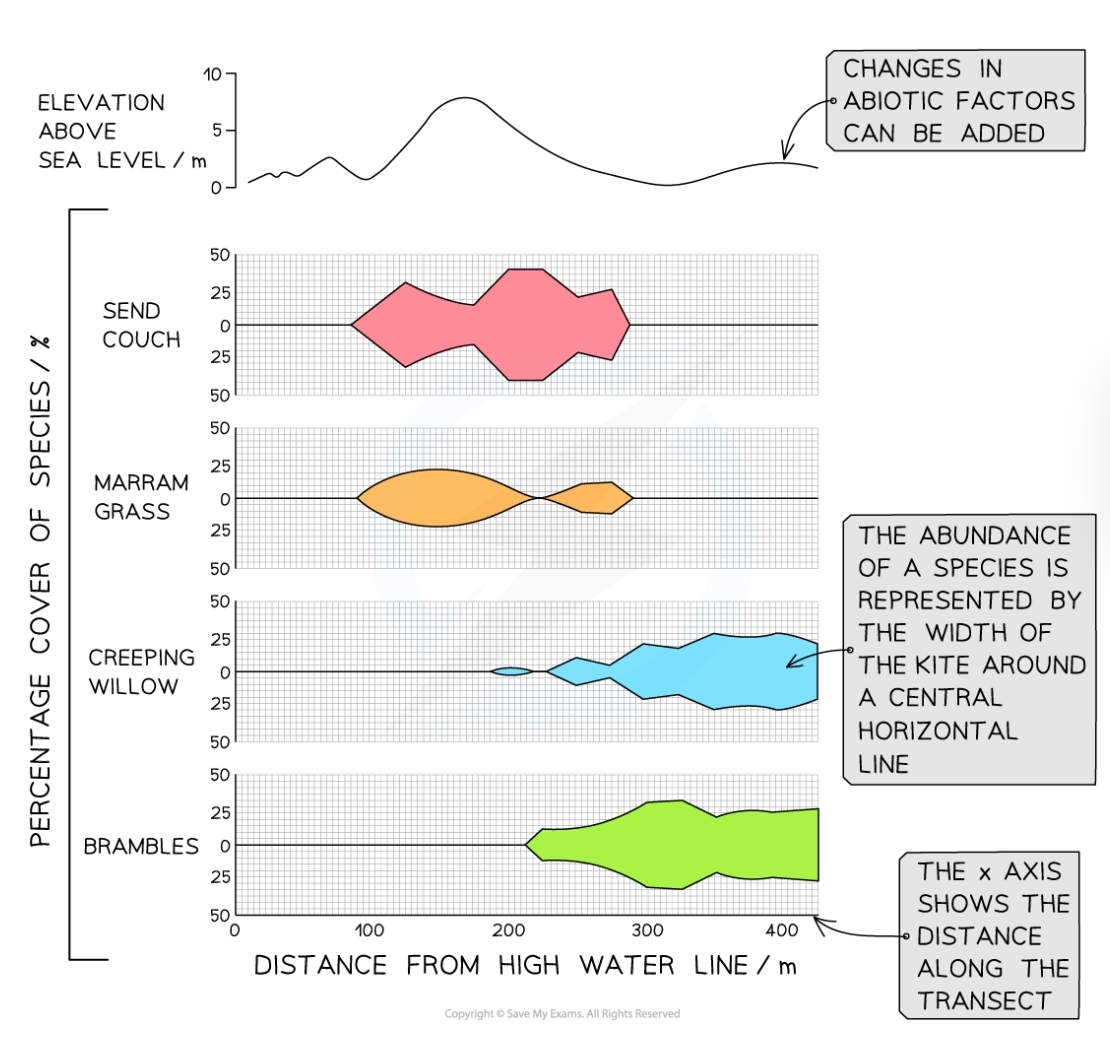
85
New cards
Additional sections of kite diagrams
* Additional sections can be added to a kite diagram to show the changes in abiotic factors at different points along a transect e.g. the height above sea level or the pH of soil
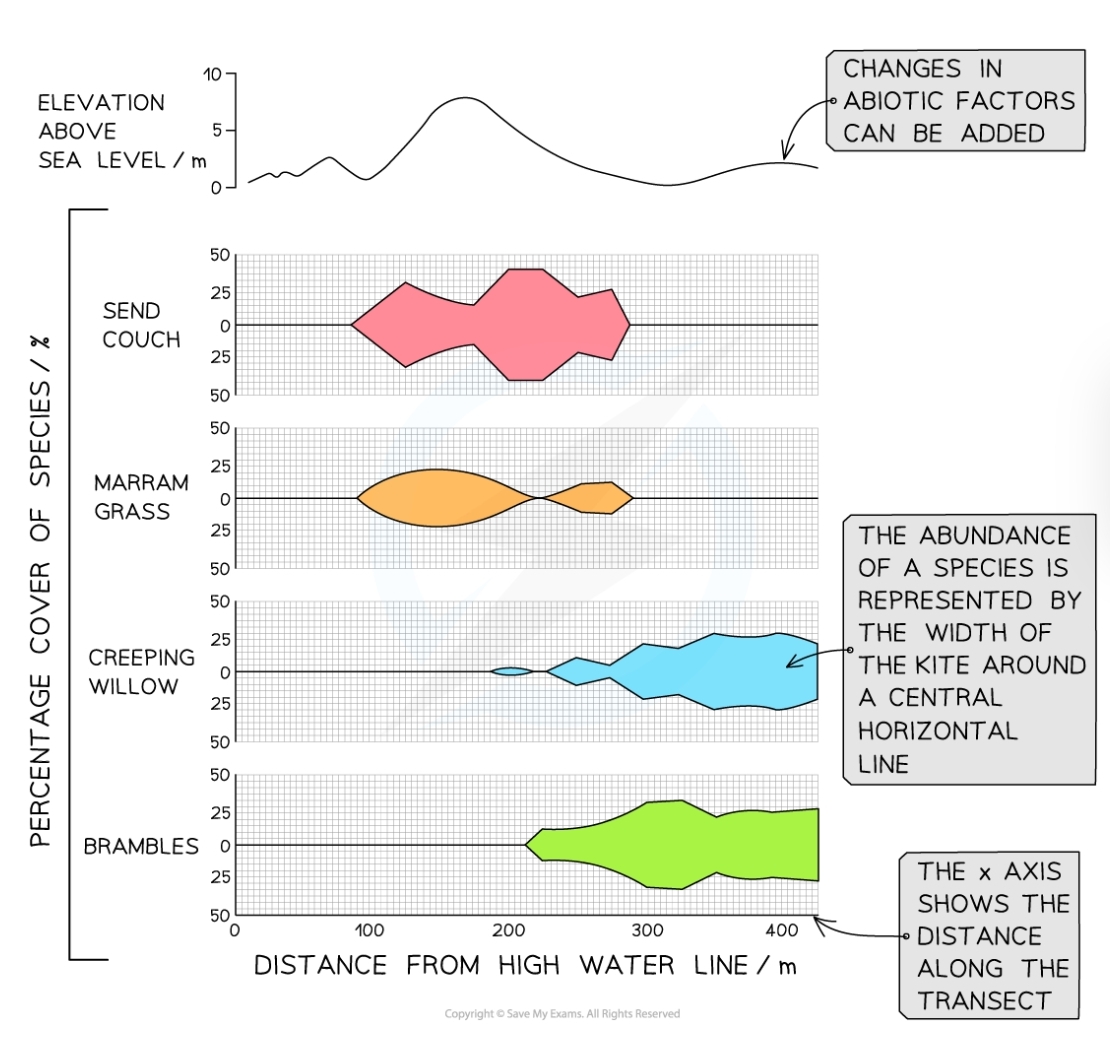
86
New cards
What does dynamic mean?
* Constantly changing
* Ecosystems are dynaic
* Ecosystems are dynaic
87
New cards
What is succession?
* The prcess of ecosystem change over time
* Biotic and abiotic conditions change
* Biotic and abiotic conditions change
88
New cards
What is primary succession?
* The process that occurs when newly formed or newly exposed land is inhabited by an increasing number of species
89
New cards
How can newly formed land be created?
* The magma from erupting volcanoes cooling and forming new rock surfaces or new rocky islands in the sea
90
New cards
How can newly exposed land be formed?
* A landslide that exposes bare rock
* A glacier that retreats to reveal bare rock
* A glacier that retreats to reveal bare rock
91
New cards
What is colonisation?
* The arrial of organisms on bare land
* The bare land is said to be colonised
* The bare land is said to be colonised
92
New cards
Where can primary succession occur?
* Any type of bare land
* Including sand dunes at the edge of the ocean, and on exposed rock
* Including sand dunes at the edge of the ocean, and on exposed rock
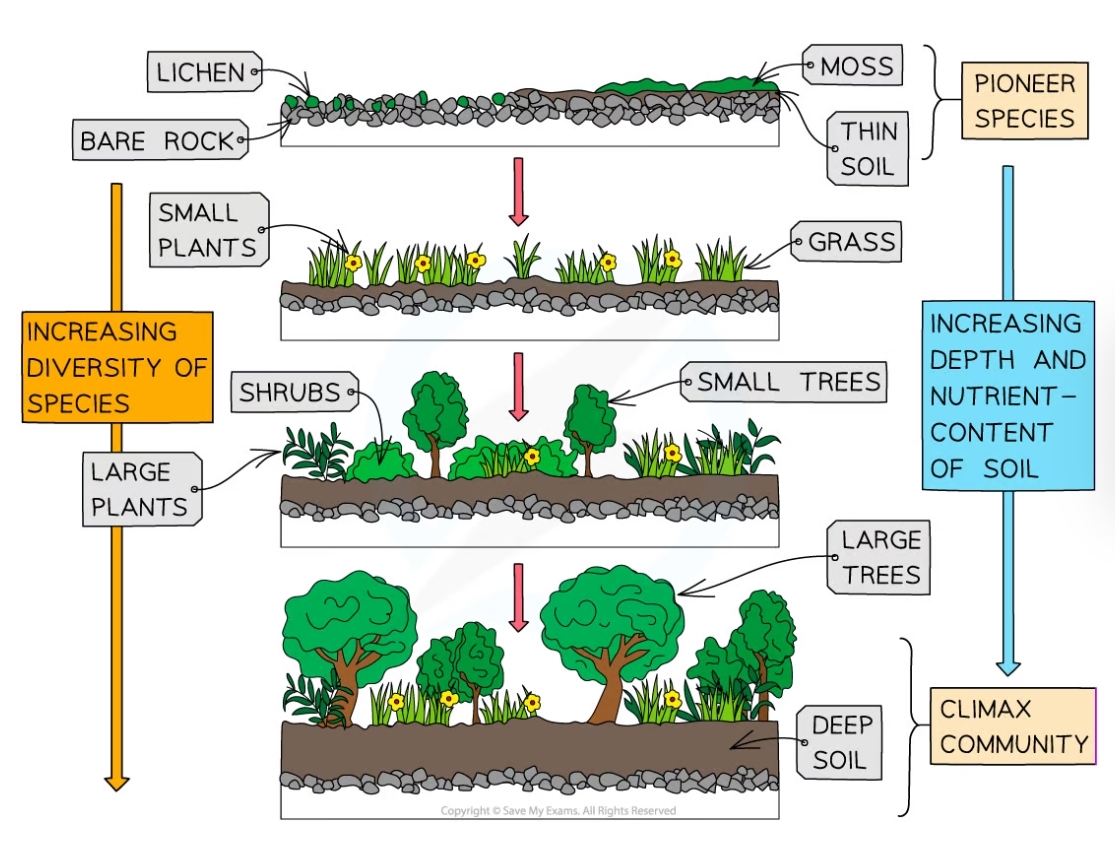
93
New cards
Stages of primary succession on bare rock
* Seeds and spores that are carried by the wind land on exposed rock and begin to grow
* As pioneer species die and decompose, the dead organic matter forms soil
* Seeds of small plants and grasses land on this soil and begin to grow
* The plants at this early stage of succession are adapted to survive in shallow, nutrient-poor soils
* The roots of these small plants form a network that helps to hold the soil in place and prevent it from being washed away
* As these small plants die and decompose, the soil becomes deeper and more nutrient-rich
* Larger plants and shrubs, as well as small trees can now begin to grow
* These larger plants and small trees also require more water, which can be stored in deeper soils
* Over time the soil becomes sufficiently deep, contains enough nutrients, and can hold enough water to support the growth of large trees
* The final species to colonise the new land become the dominant species of the now complex ecosystem
* The final community formed, containing all the different plant and animal species that have now colonised the land, is known as the climax community
* As pioneer species die and decompose, the dead organic matter forms soil
* Seeds of small plants and grasses land on this soil and begin to grow
* The plants at this early stage of succession are adapted to survive in shallow, nutrient-poor soils
* The roots of these small plants form a network that helps to hold the soil in place and prevent it from being washed away
* As these small plants die and decompose, the soil becomes deeper and more nutrient-rich
* Larger plants and shrubs, as well as small trees can now begin to grow
* These larger plants and small trees also require more water, which can be stored in deeper soils
* Over time the soil becomes sufficiently deep, contains enough nutrients, and can hold enough water to support the growth of large trees
* The final species to colonise the new land become the dominant species of the now complex ecosystem
* The final community formed, containing all the different plant and animal species that have now colonised the land, is known as the climax community
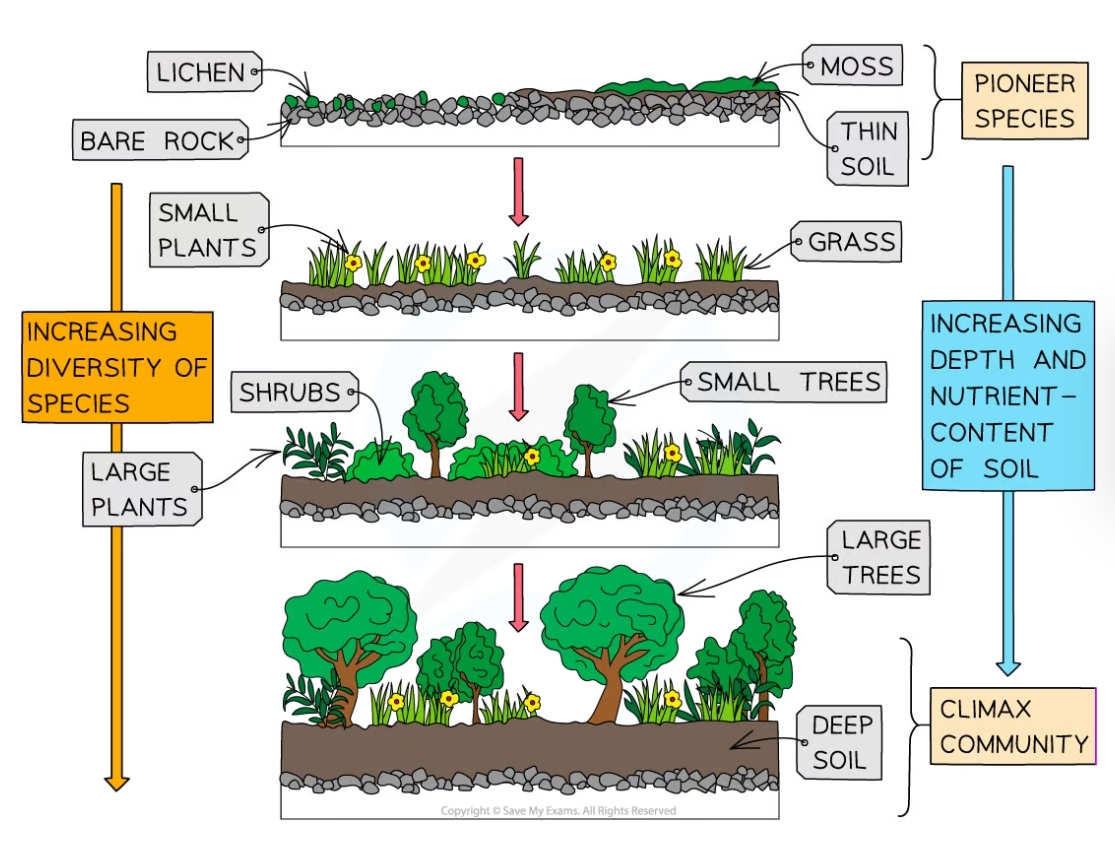
94
New cards
What are pioneer species?
* The first species to colonise the new land, often mosses and lichens
* Pioneer species can germinate easily and withstand harsh conditions such as low nutrient and water availability
* Pioneer species can germinate easily and withstand harsh conditions such as low nutrient and water availability
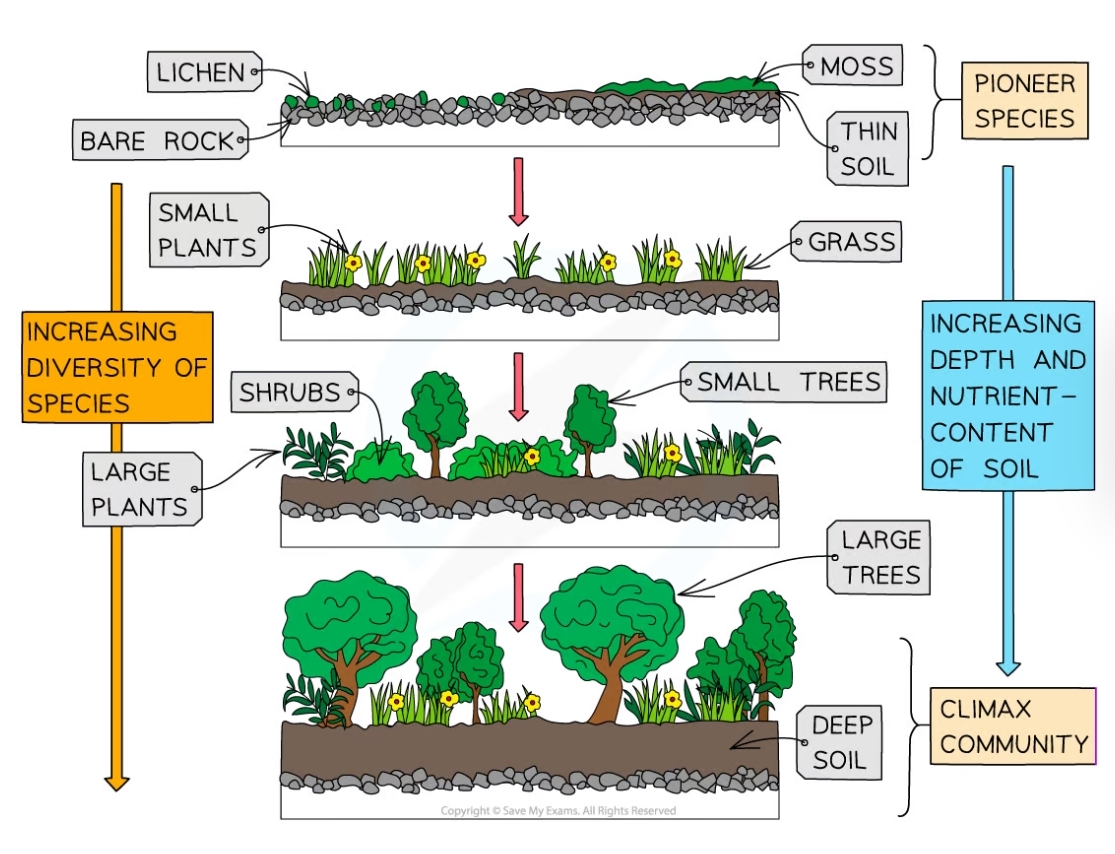
95
New cards
What does the type of climax community formed depend on?
* The location of the original bare land; in the tropics the climax community would be a rain forest, while in temperate regions it might be deciduous woodland
* A climax community is not always the most biodiverse stage of succession, but it is a stable community
* A climax community is not always the most biodiverse stage of succession, but it is a stable community
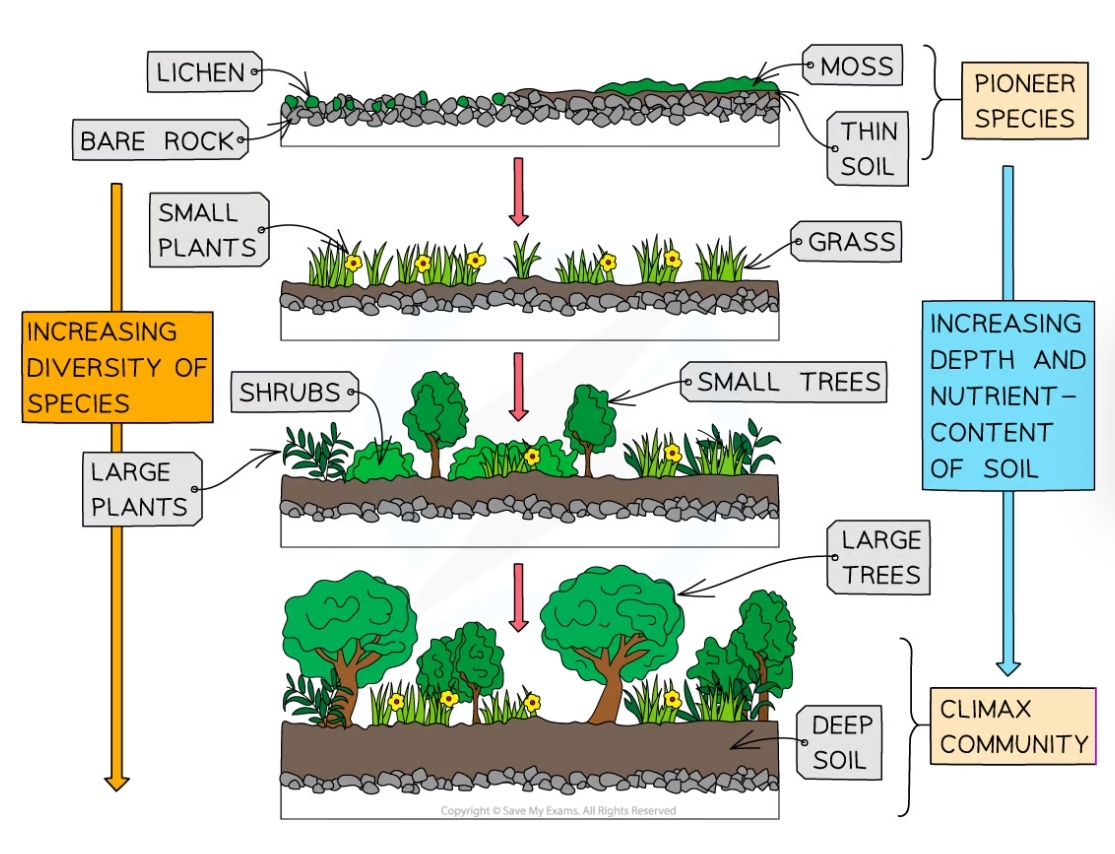
96
New cards
What happens fundamentally at each stage of succession?
* Newly arriving species cause a change in the local environment so that it becomes more suitable for other species that have not yet colonised the new land
97
New cards
How do pioneer species change the environment?
* Pioneer species such as lichens help to slowly break apart the top surface of bare rock; this fragmented rock, along with the dead organic matter left behind when the lichens die and are broken down, forms a basic soil
* Species such as grasses grow roots that stabilise the soil, enabling it to hold more moisture and nutrients
* Species such as grasses grow roots that stabilise the soil, enabling it to hold more moisture and nutrients
98
New cards
How does the change in environment that the new species create effect the previous species?
* Environment becomes less suitable for previous species
* Eg. Lichens cannot grow on soil so they disappear when soil begins to form
* Eg. Lichens cannot grow on soil so they disappear when soil begins to form
99
New cards
Why might pioneer species not be found in climax communitiess?
* They will be out-competed for light and other resources by the species that arrive during the later stages of succession
* Pioneer species are well adapted for harsh conditions but are often poor competitors
* Eg. As soil deepens and trees are able to grow, they may block out the light to shrubs and other smaller plant, out-competing them and causing them to die
* Pioneer species are well adapted for harsh conditions but are often poor competitors
* Eg. As soil deepens and trees are able to grow, they may block out the light to shrubs and other smaller plant, out-competing them and causing them to die
100
New cards
What is secondary succession?
* Very similar to primary succession except soil already present so the process begins at a later stage
* Takes place on previously occupied land
* Takes place on previously occupied land